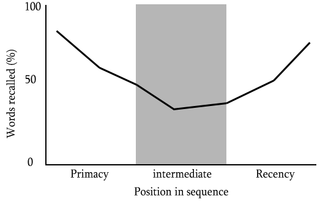 W
WActive recall is a principle of efficient learning, which claims the need to actively stimulate memory during the learning process. It contrasts with passive review, in which the learning material is processed passively. For example, reading a text about George Washington, with no further action, is a passive review. Answering the question "Who was the first US President?", is active recall. There are several variations of active recall as a strategy and these include the 3R (read-recite-review) method by McDaniel et al. and Feynman technique.
 W
WThe barrel cortex is a region of the somatosensory cortex that is identifiable in some species of rodents and species of at least two other orders and contains the barrel field. The 'barrels' of the barrel field are regions within cortical layer IV that are visibly darker when stained to reveal the presence of cytochrome c oxidase and are separated from each other by lighter areas called septa. These dark-staining regions are a major target for somatosensory inputs from the thalamus, and each barrel corresponds to a region of the body. Due to this distinctive cellular structure, organisation, and functional significance, the barrel cortex is a useful tool to understand cortical processing and has played an important role in neuroscience. The majority of what is known about corticothalamic processing comes from studying the barrel cortex, and researchers have intensively studied the barrel cortex as a model of neocortical column.
 W
WIn neuroscience, an excitatory postsynaptic potential (EPSP) is a postsynaptic potential that makes the postsynaptic neuron more likely to fire an action potential. This temporary depolarization of postsynaptic membrane potential, caused by the flow of positively charged ions into the postsynaptic cell, is a result of opening ligand-gated ion channels. These are the opposite of inhibitory postsynaptic potentials (IPSPs), which usually result from the flow of negative ions into the cell or positive ions out of the cell. EPSPs can also result from a decrease in outgoing positive charges, while IPSPs are sometimes caused by an increase in positive charge outflow. The flow of ions that causes an EPSP is an excitatory postsynaptic current (EPSC).
 W
WForgetting or disremembering is the apparent loss or modification of information already encoded and stored in an individual's short or long-term memory. It is a spontaneous or gradual process in which old memories are unable to be recalled from memory storage. Problems with remembering, learning and retaining new information are a few of the most common complaints of older adults. Studies show that retention improves with increased rehearsal. This improvement occurs because rehearsal helps to transfer information into long-term memory.
 W
WThe forgetting curve hypothesizes the decline of memory retention in time. This curve shows how information is lost over time when there is no attempt to retain it. A related concept is the strength of memory that refers to the durability that memory traces in the brain. The stronger the memory, the longer period of time that a person is able to recall it. A typical graph of the forgetting curve purports to show that humans tend to halve their memory of newly learned knowledge in a matter of days or weeks unless they consciously review the learned material.
 W
WGeneral knowledge is information that has been accumulated over time through various mediums. It excludes specialized learning that can only be obtained with extensive training and information confined to a single medium. General knowledge is an essential component of crystallized intelligence. It is strongly associated with general intelligence and with openness to experience.
 W
WSynaptic plasticity refers to a chemical synapse's ability to undergo changes in strength. Synaptic plasticity is typically input-specific, meaning that the activity in a particular neuron alters the efficacy of a synaptic connection between that neuron and its target. However, in the case of heterosynaptic plasticity, the activity of a particular neuron leads to input unspecific changes in the strength of synaptic connections from other unactivated neurons. A number of distinct forms of heterosynaptic plasticity have been found in a variety of brain regions and organisms. These different forms of heterosynaptic plasticity contribute to a variety of neural processes including associative learning, the development of neural circuits, and homeostasis of synaptic input.
 W
WHomosynaptic plasticity is one type of synaptic plasticity. Homosynaptic plasticity is input-specific, meaning changes in synapse strength occur only at post-synaptic targets specifically stimulated by a pre-synaptic target. Therefore, the spread of the signal from the pre-synaptic cell is localized.
 W
WHyperfocus is an intense form of mental concentration or visualization that focuses consciousness on a subject, topic, or task. In some individuals, various subjects or topics may also include daydreams, concepts, fiction, the imagination, and other objects of the mind. Hyperfocus on a certain subject can cause side-tracking away from assigned or important tasks.
 W
WShort-term memory for learned associations has been studied using the match-to-sample task. The basic procedure begins by presenting a subject with a stimulus that they will be required to remember, known as the 'sample'. They are then required to identify from a subsequent set of stimuli one that 'matches' the sample, known as the comparison stimuli. While the correct comparison stimulus option often matches the sample identically, the task can require a symbolic match or a matching of similar features.
 W
WMemory conformity, also known as social contagion of memory, refers to the phenomenon where memories or information reported by others influences an individual and is incorporated into the individual's memory. Memory conformity is a memory error due to both social influences and cognitive mechanisms. Social contamination of false memory can be exemplified in prominent situations involving social interactions, such as eyewitness testimony. Research on memory conformity has revealed that such suggestibility and errors with source monitoring has far reaching consequences, with important legal and social implications. Memory conformity is closely related to the Mandela effect which surfaces after one learns misleading information following the experience of an event.
 W
WMemory improvement is the act of enhancing one's memory. Memory deficits, age-related memory loss, and people's want to improve their own memory have led to research on how to best help people to improve their memory. Research has also worked to determine what factors influence memory and cognition. Many different techniques to improve memory have been found, including cognitive training, psychopharmacology, diet, stress management, and exercise. Each technique has the ability to influence memory in different ways. Neuroimaging has also provided neurobiological evidence supporting holistic ways in which one can improve memory.
 W
WThe misinformation effect occurs when a person's recall of episodic memories becomes less accurate because of post-event information. For example, in a study published in 1994, subjects were initially shown one of two different series of slides that depicted a college student at the university bookstore, with different objects of the same type changed in some slides. One version of the slides would, for example, show a screwdriver while the other would show a wrench, and the audio narrative accompanying the slides would only refer to the object as a "tool". In the second phase, subjects would read a narrative description of the events in the slides, except this time a specific tool was named, which would be the incorrect tool half the time. Finally, in the third phase, subjects had to list five examples of specific types of objects, such as tools, but were told to only list examples which they had not seen in the slides. Subjects who had read an incorrect narrative were far less likely to list the written object than the control subjects, and were far more likely to incorrectly list the item which they had actually seen.
 W
WA mnemonic device, or memory device, is any learning technique that aids information retention or retrieval (remembering) in the human memory.
 W
WThe n-back task is a continuous performance task that is commonly used as an assessment in psychology and cognitive neuroscience to measure a part of working memory and working memory capacity. The n-back was introduced by Wayne Kirchner in 1958. Some researchers have argued that n-back training may increase IQ, but evidence is mixed.
 W
WNonsynaptic plasticity is a form of neuroplasticity that involves modification of ion channel function in the axon, dendrites, and cell body that results in specific changes in the integration of excitatory postsynaptic potentials (EPSPs) and inhibitory postsynaptic potentials (IPSPs). Nonsynaptic plasticity is a modification of the intrinsic excitability of the neuron. It interacts with synaptic plasticity, but it is considered a separate entity from synaptic plasticity. Intrinsic modification of the electrical properties of neurons plays a role in many aspects of plasticity from homeostatic plasticity to learning and memory itself. Nonsynaptic plasticity affects synaptic integration, subthreshold propagation, spike generation, and other fundamental mechanisms of neurons at the cellular level. These individual neuronal alterations can result in changes in higher brain function, especially learning and memory. However, as an emerging field in neuroscience, much of the knowledge about nonsynaptic plasticity is uncertain and still requires further investigation to better define its role in brain function and behavior.
 W
WPhase resetting in neurons is a behavior observed in different biological oscillators and plays a role in creating neural synchronization as well as different processes within the body. Phase resetting in neurons is when the dynamical behavior of an oscillation is shifted. This occurs when a stimulus perturbs the phase within an oscillatory cycle and a change in period occurs. The periods of these oscillations can vary depending on the biological system, with examples such as: (1) neural responses can change within a millisecond to quickly relay information; (2) In cardiac and respiratory changes that occur throughout the day, could be within seconds; (3) circadian rhythms may vary throughout a series of days; (4) rhythms such as hibernation may have periods that are measured in years. This activity pattern of neurons is a phenomenon seen in various neural circuits throughout the body and is seen in single neuron models and within clusters of neurons. Many of these models utilize phase response (resetting) curves where the oscillation of a neuron is perturbed and the effect the perturbation has on the phase cycle of a neuron is measured.
 W
WThe reminiscence bump is the tendency for older adults to have increased or enhanced recollection for events that occurred during their adolescence and early adulthood. It was identified through the study of autobiographical memory and the subsequent plotting of the age of encoding of memories to form the lifespan retrieval curve.
 W
WSerial-position effect is the tendency of a person to recall the first and last items in a series best, and the middle items worst. The term was coined by Hermann Ebbinghaus through studies he performed on himself, and refers to the finding that recall accuracy varies as a function of an item's position within a study list. When asked to recall a list of items in any order, people tend to begin recall with the end of the list, recalling those items best. Among earlier list items, the first few items are recalled more frequently than the middle items.
 W
WThe relationship between sleep and memory has been studied since at least the early 19th century. Memory, the cognitive process of storing and retrieving past experiences, learning and recognition, is a product of brain plasticity, the structural changes within synapses that create associations between stimuli. Stimuli are encoded within milliseconds; however, the long-term maintenance of memories can take additional minutes, days, or even years to fully consolidate and become a stable memory that is accessible. Therefore, the formation of a specific memory occurs rapidly, but the evolution of a memory is often an ongoing process.
 W
WIn cognitive psychology and neuroscience, spatial memory is a form of memory responsible for the recording of information about one's environment and spatial orientation. For example, a person's spatial memory is required in order to navigate around a familiar city, just as a rat's spatial memory is needed to learn the location of food at the end of a maze. It is often argued that in both humans and animals, spatial memories are summarized as a cognitive map.
 W
WSubvocal recognition (SVR) is the process of taking subvocalization and converting the detected results to a digital output, aural or text-based.
 W
WSubvocalization, or silent speech, is the internal speech typically made when reading; it provides the sound of the word as it is read. This is a natural process when reading, and it helps the mind to access meanings to comprehend and remember what is read, potentially reducing cognitive load.
 W
WSuspense is a state of mental uncertainty, anxiety, of being undecided, or of being doubtful. In a dramatic work, suspense is the anticipation of the outcome of a plot or of the solution to an uncertainty, puzzle, or mystery, particularly as it affects a character for whom one has sympathy. However, suspense is not exclusive to fiction.
 W
WStephen Wiltshire is a British architectural artist and autistic savant. He is known for his ability to draw a landscape from memory after seeing it just once. His work has gained worldwide popularity.